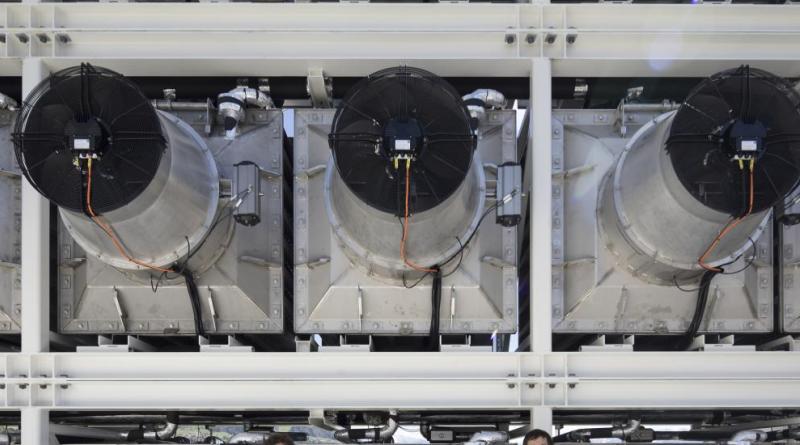6 Things to Know About Direct Air Capture

As the effects of climate change are increasingly felt through more severe storms, wildfires and flooding, the need to reduce greenhouse gas (GHG) emissions — such as by switching to electric vehicles, deploying solar panels and reducing deforestation — is critical. At the same time, the latest climate science indicates that such efforts will not be enough to keep temperature rise below 1.5 degrees C (2.7 degrees F), which would prevent the worst impacts of climate change.
While efforts to reduce GHG emissions should always take priority, meeting climate goals will also require carbon dioxide removal (CDR) — systems that remove carbon directly from the air — likely at the billion-tonne scale by mid-century. Carbon removal is needed not only to balance out residual emissions that cannot be or are not eliminated by 2050, but also to reduce the high concentration of carbon dioxide in the air, which is triggering increasingly devastating climate change impacts. The United States, as the largest cumulative historical emitter of CO2, has a responsibility to be a leader in pulling it back out of the atmosphere. The precise amount needed will depend on how fast the world reduces emissions.
Carbon removal can take numerous forms — including natural solutions like growing trees and increasing the ability of soil to sequester carbon, and technological solutions that accelerate or mimic natural carbon removal processes or directly pull CO2 from the air. Direct air capture (DAC) is one type of technological carbon removal that shows promise today and will likely be part of a larger carbon removal portfolio. Compared to other types of carbon removal it uses relatively little space and can also be sited flexibly, so would avoid competition with other land uses and could be built on marginal land or near geological storage sites to minimize the need for CO2 pipelines.
Here we answer some key questions about DAC.
1. What Is Direct Air Capture?
Direct air capture is a technology that uses chemical reactions to pull carbon dioxide out of air. When air moves over these chemicals, they selectively react with and trap CO2, allowing the other components of air to pass through. Today’s leading systems use either liquid solvents or solid sorbents, which are composed of common chemicals that are already in use in other applications today, from soap to water filtration.
Once carbon dioxide is captured from the atmosphere, heat is typically applied to release it from the solvent or sorbent. Doing so regenerates the solvent or sorbent for another capture cycle. Other systems in development use electrochemical processes, which could reduce energy needs and cost.
The captured CO2 can then be injected deep underground for sequestration in certain geologic formations or used in various products and applications. The carbon benefit of use in products, or the net quantity of carbon that is durably stored, depends on the product. Use in products like concrete or plastic can provide long-term sequestration (decades or even centuries), whereas using carbon dioxide in products like beverages or synthetic fuel would quickly re-release carbon into the atmosphere. In some cases — jet fuel for example — synthetic fuel produced with CO2 could still be a more favorable substitute for more emissions-intensive fossil fuel. However, to maximize climate benefit, most captured CO2 would need to go to vast and permanent underground sequestration rather than useful but more limited utilization routes.
2. How Technologically Ready is Direct Air Capture for Widespread Use?
DAC has seen a surge in interest and investment over the past few years and a growing number of companies are entering the space. This is due to the understanding that carbon removal will increasingly be needed to meet national and global climate goals, along with benefits of DAC compared to other carbon removal approaches, which include few practical limits on scaling, relatively little land area use, and siting flexibility.
Companies with the most developed technologies today include Climeworks, Carbon Engineering and Global Thermostat (see table below). Together these companies have 18 plants of varying sizes (1 tCO2/yr up to 4,000 tCO2/yr capacity, the largest plant in operation today) capturing a total of just under 8,000 tCO2/yr. Around half of that is sequestered permanently — similar to the annual emissions from 870 cars — while the other half is sold for use in various products.
A DAC plant with one million-tonne per year capacity is under development in the Southwest of the U.S. and is expected to be operational in late 2024. Other companies have been established more recently, using solvent, sorbent and other innovative types of technology.
DAC is currently categorized as “technology readiness level” 6 (on a scale of 1 to 9), meaning it’s still in the large-scale and prototype phase, not yet ready for full commercial deployment. But this also means there’s ample opportunity to improve performance and reduce costs through learning from early iterations of the technology.
3. How Much Does Direct Air Capture Cost?
Despite the benefits and flexibility, direct air capture is more costly per tonne of CO2 removed compared to many mitigation approaches and natural climate solutions as it is energy intensive to separate carbon dioxide from ambient air. The range of costs for DAC vary between $250 and $600 today depending on the technology choice, low-carbon energy source, and the scale of their deployment; for comparison, most reforestation costs less than $50/tonne.
However, depending on the rate of deployment, which could accelerate through supportive policies and market development, costs for DAC could fall to around $150-$200 per tonne over the next 5-10 years. Going further than this, the Department of Energy launched its Carbon Negative Shot initiative in late 2021, which aims to reduce the cost of carbon removal technologies and approaches that could reach gigaton scale to $100/tCO2 over the next decade.
Another reason for high costs today is there are relatively few DAC companies and projects — developing more projects will provide learning that could reduce costs. And it’s important to note that DAC offers quantifiable and permanent storage, whereas natural carbon removal solutions like trees are at risk of deforestation and climate change induced threats like wildfires and drought.
DAC also provides atmospheric clean-up, which is a public good rather than a product people need to purchase, so opportunities for direct revenue are more limited. Captured CO2 can be sold for use in products from concrete aggregate to carbon fiber, markets that don’t typically provide enough revenue to offset the cost of capture. The largest market for CO2 today is enhanced oil recovery (EOR), which is controversial given its connection to fossil fuel production.
Ultimately, the greatest climate benefit for DAC comes from geologic sequestration for which there is no revenue opportunity beyond public policy support. Public investment in and support of carbon removal technology has increased in the past few years, but more will be needed to scale sufficiently and avoid the worst impacts of climate change.
4. What Policies and Investments are Supporting DAC Development in the U.S.?
The most important federal policy supporting DAC today is the 45Q tax credit, which provides up to $35-50 per tonne of CO2 captured through DAC and carbon capture at point sources ($50/tCO2 if the captured carbon is sequestered underground and $35/tCO2 if it’s used for EOR or elsewhere). There have been several legislative proposals to enhance 45Q by providing higher credit values and extending its timeline, along with other changes.
The federal government also funds research, development and demonstration for many types of carbon removal, including DAC. The Department of Energy’s funding for CDR has increased significantly from less than $10 million 2009-2019 to $129 million in the most recent (fiscal year 2022) budget.
The Bipartisan Infrastructure Law also provides an unprecedented amount of funding over the next five years specifically for DAC: $3.5 billion for four DAC hubs, $100 million for a commercial DAC prize, and $15 million for a pre-commercial DAC prize. There is also $4.6 billion funding to support enabling infrastructure like CO2 pipelines and geologic sequestration, which is needed for both DAC and point source capture, like capturing emissions from cement plants.
At the state level, California’s Low-Carbon Fuel Standard provides a credit for DAC plants, either inside or outside of California, on the order of $200/tCO2. This credit was instrumental to making Carbon Engineering’s million-tonne DAC plant — currently in development in the U.S. Southwest — economically viable. It will be the first large-scale DAC plant in the world.
Various other bills have been introduced at the federal and state levels to support carbon removal. The Federal Carbon Dioxide Removal Leadership Act would require the federal government to procure increasing amounts of carbon removal. A similar bill in New York state — the Carbon Dioxide Removal Leadership Act — would require state procurement of CDR.
In addition to federal and state policies, corporate investment in carbon removal and DAC is also increasing. This has been led by companies like Stripe, Shopify and Microsoft which have committed hundreds of millions of dollars to carbon removal, including DAC. Many other companies aside from these early movers are making purchases as well.
5. What are the Unintended Impacts of Using Direct Air Capture?
While organizations like the IPCC indicate the need for significant amounts of carbon removal to meet our climate goals, care must be taken to ensure that ramping up DAC does not distract from essential attention and investment in other mitigation measures, especially to reduce fossil fuel use. Scientists indicate we will need both faster emissions reduction and carbon removal, and the amount of carbon removal needed is inversely proportional to how deeply we are able to cut emissions.
Strong policy and private sector guardrails are needed to ensure countries and companies do not over-rely on carbon removal at the expense of emissions reductions. For example, the Science Based Target initiative’s recent net-zero guidance requires companies to meet their climate targets by reducing more than 90% of their own emissions and using carbon removal to compensate for only the remaining 5-10% that they cannot directly mitigate.
With DAC, some are concerned about the connection to fossil fuel production through EOR (as mentioned before), which uses captured CO2 to produce more oil from depleted wells. While EOR permanently sequesters the injected CO2, it also produces oil, which produces more emissions. Fossil fuel company investments in DAC with EOR can thus be seen as a way to continue producing fossil fuels and slowing the energy transition.
For all types of CO2 capture, community concerns have been raised around CO2 pipelines and geological storage of CO2, particularly around safety and the possibility of leakage for both. These concerns are especially salient given a 2020 CO2 pipeline rupture in Mississippi paired with $4.6 billion in funding through the Bipartisan Infrastructure Law for CO2 transport and storage. CO2 pipelines have been used since the 1970s and, like oil and gas pipelines, pose non-zero risks. However, with expected investment ramping up, attention is needed to ensure they have adequate safeguards for operational safety as well as consideration of impact on the environment and people. Geological storage has been demonstrated safely at million-tonne volumes, but expanding to multi-million or billion tonne scales similarly requires further attention to regulatory needs.
Because DAC is a newer type of infrastructure, there is limited information about how it would impact local communities — either positively or negatively. More research will be needed to understand these impacts on a project-by-project basis along with proactive engagement with potentially affected communities.
6. What are the Main Resource Impacts of DAC?
Energy
The two main direct air capture systems in use today have different temperature requirements, which impacts the types of energy required to operate them. Liquid solvent systems require 900 degrees C (1652 degrees F) to release captured CO2, whereas solid sorbent systems require 80 degrees C to 120 degrees C (176 to 248 degrees F). This means that solid sorbent systems can use waste heat or renewable energy, while solvent systems currently rely on natural gas with carbon capture and storage. For both systems, the energy is roughly 80% heat and 20% electricity.
Energy sources need to be zero- or very low-carbon to maximize net capture efficiency —otherwise more CO2 emissions will be produced using the energy than would be captured from the air in the process. Climeworks’ solid sorbent system estimates a long-term energy requirement of 7.2 GJ (or 2,000 kWh/tCO2) — equivalent to around one-fifth of a U.S. household’s annual natural gas consumption — while near-term energy needs would be a bit higher. Carbon Engineering has similarly estimated energy requirements of around 8.8 GJ/tCO2 (or 2,400 kWh/tCO2).
Scaling up today’s DAC systems would use non-trivial amounts of energy. Reaching 7-9 million tonnes per year of capture capacity in the U.S. by 2030 (proposed by the Bipartisan Policy Center’s DAC Council and the Rhodium Group, respectively) would use 0.3-0.4% of today’s U.S electricity generation. Capacity of renewable energy sources already needs to expand significantly to decarbonize power production and electrify sectors like buildings and transport, and additional renewable capacity would also be needed for DAC and other types of carbon removal, so as not to compete with other uses. This renewable energy scale up will come with its own impacts, such as those related to expanded mining activities for rare earth metals.
Learning through deployment could help optimize existing systems to reduce energy needs, while research and development funding will help develop entirely new systems with lower energy burdens.
Land
One of the biggest benefits of direct air capture is siting flexibility. DAC does not require arable land, which can minimize impacts on food production or other land uses. The land area needed for large-scale deployment depends on the type of DAC system and the energy resource powering it. If renewables are used, they will be the largest portion of the land footprint.
DAC requires a smaller amount of land per tonne of CO2 removed than some other leading CDR approaches, like reforestation. To capture one million tonnes of CO2, a DAC plant would need 0.4 to 66 km2 for the plant and the energy resource, while capturing a similar amount of CO2 from forests would require an estimated 862 km2.
Both tree restoration and DAC, along with other approaches and technologies, have tradeoffs that must be weighed up because they are all needed as part of a larger carbon removal portfolio.
Water
Water usage associated with direct air capture also depends on the system type, as well as local temperature and humidity.
For a solvent DAC system, capturing one tonne of CO2 can require 1-7 tonnes of water for plausible siting locations in the U.S., comparable to the amounts of water required to produce a tonne of cement or steel. Water losses come mainly through evaporation, so the relative humidity and temperature of the plant’s location are the main determinants of the level of water loss, with higher losses in hot and dry environments.
The solid sorbent DAC systems in development and production today vary widely in terms of water usage, depending on the sorbent regeneration method. A system that uses steam condensation to regenerate the sorbent may result in water losses to the environment — a typical plant may use 1.6 tonnes of water per tonne of CO2 captured. Other systems regenerate the sorbent using indirect heating, meaning minimal water losses. And these indirect heating systems, such as Climeworks’ solid sorbent systems, are actually net water producers, yielding an estimated 0.8-2 tonnes of water per tonne of CO2 captured.
Because resource usage is linked to community impacts, the people living near DAC plants or parts of the DAC supply chain will also be impacted.
Direct Air Capture: An Important Part of a Climate Solution Portfolio
Climate models make it increasingly clear that carbon dioxide removal will likely need to happen on a multi-billion-tonne scale by mid-century along with deep emissions reductions. And the slower we are to reduce emissions, the more we may need to rely on carbon removal — including DAC — to meet national and global climate goals. Achieving large-scale carbon removal will require a portfolio of different approaches, which will reduce cost and the risk of any one approach failing to provide expected removal. Investing in DAC now will help reduce future costs, which can prove critical as carbon dioxide removal becomes even more necessary.






